
|

|
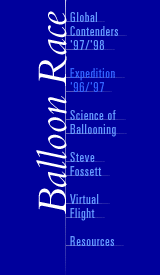
|

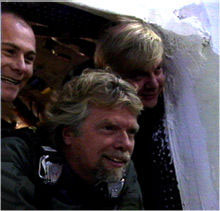
Rory McCarthy
Richard Branson
Per Lindstrand

Marrakech, Morocco (approximately 31 degrees latitude)

Time of Year: Optimal meteorological conditions occur
from November 1 to March 1 when the jet stream winds, the
primary source of propulsion for the balloon, blow in a west
to east direction.
Altitude: The balloon will travel within the jet
stream at an average altitude of 33,000 feet.
Speed: The jet stream moves at a ground speed of up
to 250 miles per hour, with an average speed of 70 miles per
hour.
Outside Air Temperature: Minus 65 degrees
Fahrenheit
Flight Duration: Assuming the flight trajectory moves
in a straight west to east direction, and given that the
distance around the earth at 31 degrees latitude is
approximately 20,000 miles, the balloon could circumnavigate
the earth in 12 days. However, the likelihood of flying in a
direct west-east weather pattern, without moving north or
south, is slim. Therefore, the flight could take as long as
21 days.

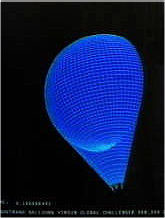
Design: The balloon is a De Rozier, which was a
system designed by Jean Pilatre De Rozier of France in 1789.
It utilizes both helium and hot air. No one has ever flown a
De Rozier balloon of this size under these altitude and
flight duration conditions.
Height: 206.64 feet or 63 meters
Diameter: 127.92 feet or 39 meters
Capacity: 32,000 cubic meters or 1.1 million cubic
feet
Color: White
Registration: G-GLBL
Fabric: The balloon envelope is made from a high
tenacity polyamide fabric coated with a polyurethane
compound, and an outer layer of aluminised melinex
industrial film. This new laminated fabric has increased
protection from ultraviolet light and cuts down on gas
leakage.

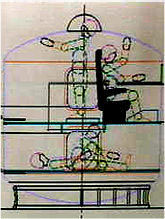 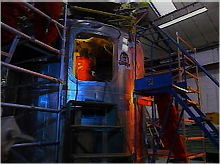
Design: Designed by Per Lindstrand, the capsule is
pressurized to an equivalent interior atmospheric pressure
of 8,000 feet. It is constructed of aluminum. There are two
propane-powered engines driving compressors which maintain
the inside pressure. The capsule is a bi-level construction.
The lower level serves as the sleeping quarters, toilet
facility, storage space, and access hatch. The upper level
is the piloting center with balloon control panels,
navigation, and communications equipment.
Fuel: Six fuel tanks are mounted outside the capsule.
They contain the propane gas that will power the balloon
burners.
Height: 10.8 feet
Diameter: 9.5 feet
Weight: 4,400 pounds
Fuel Cylinders: 2,060 pounds

Total Weight: 12 tons or 25,000 pounds
Total Estimated Lift at Launch: 13.5 tons of lift
Total Estimated Lift at Float Altitude: 12 tons

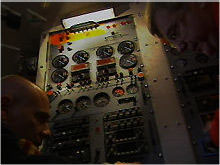
Inmarsat Standard C: Utilizing standard Global
Positioning Satellite Systems, this unit provides real-time
tracking of the balloon's exact position and speed. This
two-way satellite communications system also enables data
transfer and E-mail between the capsule and the ground.
Inmarsat Standard M Satellite Phone: Allows for voice
communication between the capsule and the ground.
HF Radio: With an estimated 6,000 mile range, this
system has an air traffic control contact over the Pacific
and Atlantic Oceans.
VHF Radio: With a range of 200 miles this
communications system allows for air-to-air and
air-to-ground communication. It also is the means for Air
Traffic Control communication in the United States and
Europe.

Ozone instruments will be taken along to measure the
presence of halocarbons in the atmosphere.
Global Contenders '97/'98
|
Expedition '96/'97
| Fossett |
Virtual Flight
Science of Ballooning
|
Teacher's Guide
| Resources |
Transcript
| Balloon Home
Editor's Picks
|
Previous Sites
|
Join Us/E-mail
|
TV/Web Schedule
About NOVA |
Teachers |
Site Map |
Shop |
Jobs |
Search |
To print
PBS Online |
NOVA Online |
WGBH
©
| Updated October 2000
|
|
|






